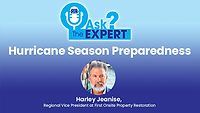Time to Recheck Your Hurricane Preparedness

This year’s Atlantic hurricane season is off to an active start. An average hurricane season has about 12 named storms. During the current season, the sixth named storm (called Fay) had already formed by early July, becoming the earliest-in-season “F” Atlantic storm on record. The trend continued with Hurricane Hanna moving in late July through southern Texas.
It’s important to keep in mind that hurricane season typically peaks in the middle of September. So, there’s still potentially a number of storms ahead. The Weather Company forecasts 20 named storms this year, eight of which are expected to become hurricanes, and four of those hurricanes becoming major hurricanes.
With the Atlantic hurricane storm season moving at a record pace, this makes it a good time for restoration and remediation contractors to recheck their preparedness to answer the call from customers for hurricane-related services.
Gearing Up to Respond Quickly
When a disaster happens, customers rely on restoration and remediation companies to find a solution and mitigate interruption and loss – fast.
Complementing owned equipment inventory with rental equipment can be a smart move. When renting, contractors pay only for the equipment they need, at the time they need it. Rental equipment contract periods provide the flexibility to get the right equipment to address the job at hand.
Ownership also carries extra costs for maintaining equipment and periodic repairs, which can mean investing in a parts inventory. Then there is the need for a shop space, properly outfitted for safety operations, but the greatest cost by far is labor. An expansion in owned fleet usually means hiring and training more service technicians – and keeping them trained on the latest gear. With rental, all of these costs and responsibilities fall to the rental company.
Another factor is transport. When a contractor owns the equipment, they are responsible for hauling the equipment to the disaster site, as well as for storage between jobs. Rental companies can get equipment to sites quickly and efficiently, using computerized maintenance programs and GPS systems to keep tabs on location, status and service needs.

Sourcing Equipment and Solutions
When evaluating equipment rental resources, contractors need to look for a provider that understands how important it is to help keep crews safe and productive while keeping
costs down.
Equipment availability and reliability are essential in disaster response operations. To help keep interruptions and recoveries brief, companies can have a range of equipment needs, including emergency response trailers, air quality machines, floor care products, aerial platforms, pump solutions and perhaps even, completely custom-engineered solutions. Contractors should turn to equipment rental providers with equipment inventory and availability to supply what is needed.
As part of their planning, contractors need to explore whether they can depend on their rental providers when they need them to meet unexpected needs, such as disaster response. In these instances, time is in short supply and personnel need to understand who they can immediately call and depend on to support them. Companies need an established partner in the wings with a single point of contact that can be trusted to deliver in any situation, one who can help put in place contingency plans to address the possible unfortunate events that may arise.
Contractors need to be able to rely on on-site consultation and forward planning before any event: Who to call in the event of an emergency? What equipment and support will be needed? What are the costs going to be? And of course, the provider needs to have a track record of expeditiously delivering quality equipment that is available 24/7/365.
Delivering emergency response cleanup requires more than just equipment. An equipment rental service provider must be ready and able to work with a contractor, as a partner. This collaboration can span from implementing on-site power distribution to setting up air circulation and drying solutions. Whatever support a company needs, the equipment rental company needs to be able to help respond whenever catastrophe strikes and deliver services to address disasters of any size.
Creating a Safe Environment
As restoration and remediation contractors manage through the COVID-19 crisis, it is important that they have more options when renting needed equipment, safely and efficiently. In addition to having equipment delivered to a worksite or available to an equipment rental provider branch, providers should offer a “contactless” drive-up experience to pick up or drop off equipment that helps serve contractors faster, and keeps them safe.
Contractors should also have many options for how they order equipment to get what they need without going inside a branch. These include the ability to browse and reserve equipment online, on the phone or with mobile apps from smartphones.
Contractors need to check to be sure their equipment rental provider is taking the necessary steps to safeguard its fleet is sanitary and ready for use. These steps may include that prior to equipment being rented, employees conducting a variety of safety and mechanical checks to assure the equipment functions correctly and safely. In addition to these routine checks, providers should disinfect the equipment.
If the rental provider is dropping equipment off at a worksite, be sure their drivers perform a “last touch” precautionary disinfecting of the equipment. They should use a government-approved disinfectant and spray or wipe the surfaces touched by the driver when delivering the equipment.
Getting Better Prepared with a Partner
Every disaster, from a cat loss to a minor emergency disruption, can be devastating to a customer – in any sector. By teaming with an equipment rental partner, restoration and remediation contractors can help keep their customers’ interruptions and recoveries brief by having the essential resources needed to get the job done.
Looking for a reprint of this article?
From high-res PDFs to custom plaques, order your copy today!






